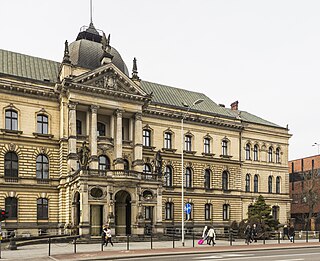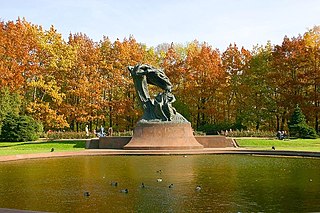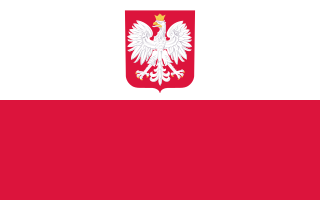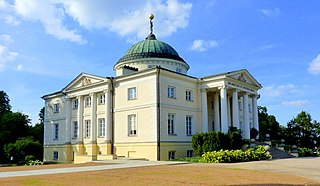


Mariemont Palace was a small summer palace of the kings of Poland. It was located in Marymont, a northern neighbourhood of Warsaw, Poland. Today, nothing remains of this pleasure pavilion, and a church stands on its location.



Mariemont Palace was a small summer palace of the kings of Poland. It was located in Marymont, a northern neighbourhood of Warsaw, Poland. Today, nothing remains of this pleasure pavilion, and a church stands on its location.
At the behest of king John III Sobieski, a palace was constructed between 1691 and 1696 for his wife, queen Marie Casimire. [1] [2] The design was made by the Dutch architect Tylman van Gameren . [1] The palace was named ‘Mariemont’ after the queen, meaning Mary’s hill. [1] [2]
It was a charming, compact building intended to be used as a pleasure pavilion for summer times and basis to go hunting. [1] [2] It was located on a lofty embankment along the Vistula river. [1] [2] The main structure featured multiple floors and had a square layout, crowned with an elegant tented roof and an intricately designed onion dome. [1] [2] The first floor, known as the "piano nobile," served as the noble living space. [1] [2] The palace's facades were uniformly adorned with frames and decorative pilasters, creating a harmonious aesthetic. [1] [2]
In 1727, the Sobieski family sold the palace to king Augustus II the Strong of Poland, who was also Elector of Saxony. He undertook extensive renovations and established a menagerie. [1] [2] [3] The architect Joseph Christoph Naumann helped in the design of the renovations. [3] Various plans can still be found in the Saxon State main archive in Dresden. [3]
Both August II and his son, king Augustus III of Poland, regularly used Mariemont as a hunting lodge for trips into the Bielański forest and the Kampinos forest. [1] [2] [3] The hunting trips could take up to two days with more than five thousand participants. [3] In a hunting trip at Mariemont in 1724 around 700 aristocrats participated, around 200 hunters, and 4,000 peasants who helped as drivers). [3] When Stanisław August Poniatowski became king of Poland in 1764, Mariemont palace remained in the possession of the Saxon Electors. [3] They leases the palace out to various users, such as the English ambassador. [3] After the Third Partition of Poland in 1795, they sold all their possessions to Prussia. [3]
In 1816, an agronomic institute was established in the grounds of the palace. [2] After the January Uprising in 1863 and 1864, the palace and the institute were transferred to the Imperial Russian Army to be used as cavalry barracks. [2] In the palace a military warehouse was set-up, and its architecture was damaged. [2] Today, nothing remains anymore of the palace. On its foundations, a catholic church has been constructed. [2] During renovation works in 2016, archaeological research has been performed. [2]

Szczecin is the capital and largest city of the West Pomeranian Voivodeship in northwestern Poland. Located near the Baltic Sea and the German border, it is a major seaport and Poland's seventh-largest city. As of 31 December 2022, the population was 391,566.

John III Sobieski was King of Poland and Grand Duke of Lithuania from 1674 until his death in 1696.

Sigismund III Vasa was King of Poland and Grand Duke of Lithuania from 1587 to 1632 and, as Sigismund, King of Sweden and Grand Duke of Finland from 1592 to 1599. He was the first Polish sovereign from the House of Vasa. Religiously zealous, he imposed Roman Catholicism across the vast realm, and his crusades against neighbouring states marked Poland's largest territorial expansion. As an enlightened despot, he presided over an era of prosperity and achievement, further distinguished by the transfer of the country's capital from Kraków to Warsaw.

Augustus II the Strong, was Elector of Saxony from 1694 as well as King of Poland and Grand Duke of Lithuania from 1697 to 1706 and from 1709 until his death in 1733. He belonged to the Albertine branch of the House of Wettin.

The House of Lubomirski is a Polish princely family. The Lubomirski family's coat of arms is the Drużyna coat of arms, which is similar to the Szreniawa coat of arms but without a cross.

Łazienki Park or Royal Baths Park is the largest park in Warsaw, Poland, occupying 76 hectares of the city center.

Gniew is a historic town situated on the left bank of the Vistula River, in the Pomeranian Voivodeship, in northern Poland. It has 6,870 inhabitants (2016). It is one of the oldest towns in Eastern Pomerania, and is renowned for its medieval brick gothic Castle, which has become one of the region's most recognizable monuments.

Marymont is one of the northern neighbourhoods of Warsaw, Poland, administratively a part of the boroughs of Żoliborz (Marymont-Potok) and Bielany. Named after the queen of Poland Marie Casimire, wife of King John III Sobieski, it initially housed a small summer manor, Mariemont Palace. In the 18th century, it became notable for the large number of windmills located there on the high escarpment of the Vistula. In the 19th century, the area became one of the favourite weekend resting places, joined with the city centre by boat communication and a horse tram. In the 1920s, parts of the neighbourhood were built-up with residential areas. The Marymont Warsaw Metro station opened here in December 2006.

Tylman van Gameren, also Tilman or Tielman and Tylman Gamerski, was a Dutch-born Polish architect and engineer who, at the age of 28, settled in Poland and worked for Queen Marie Casimire, wife of Poland's King John III Sobieski. Tylman left behind a lifelong legacy of buildings that are regarded as gems of Polish Baroque architecture.

The bilateral relations between Poland and Germany have been marked by an extensive and complicated history.

Equestrian Portrait of Count Stanislas Potocki is an oil painting on canvas completed by the French Neo-Classical painter Jacques-Louis David in 1781. A large-scale equestrian portrait, the work depicts a Polish politician, nobleman, and writer of the Enlightenment Period, Stanisław Kostka Potocki. The artist shows Potocki on horseback and wearing the sash of the Polish Order of the White Eagle. As Potocki tips his hat in a welcoming gesture to the viewer, the horse bows, while a dog can be seen barking in the lower left-hand corner of the painting.

Lelewel Palace was a rococo palace on the Miodowa Street in the Warsaw Old Town, which was also unofficially named "Palace Street". Lelewel Palace was built in 1755 by Efraim Szreger on an estate documented to have been property of King John III Sobieski and maintaining the original Corps de logis. The client and owner until 1787 was Constance Lelewel née Jauch.

The Museum of King John III's Palace at Wilanów is a museum in Warsaw, Poland considered to be one of the oldest in the country and the repository of the country's royal and artistic heritage. The collection consists of valuables collected by subsequent owners of the Wilanów Palace, the Kings of Poland — John III Sobieski and Augustus II, as well as by representatives of noble families of Potocki, and Lubomirski and a collection of Sarmatian art.
The following is a timeline of the history of the city of Gdańsk, Poland.

The Basilica Cathedral of St. Mary of the Assumption is a large Gothic building situated in the Polish city of Włocławek located near to the Vistula River. Construction on the cathedral began in the 1340s, and it was consecrated in 1411. It was still under construction in the 15th and at the beginning of the 16th century, until its completion in 1526. It is one of the greatest treasure troves of funerary art in Poland next to the cathedrals in Gniezno, Poznań and Kraków.

Compendium ferculorum, albo Zebranie potraw is a cookbook by Stanisław Czerniecki. First put in print in 1682, it is the earliest known cookery book published originally in Polish. Czerniecki wrote it in his capacity as head chef at the court of the house of Lubomirski and dedicated it to Princess Helena Tekla Lubomirska. The book contains more than 300 recipes, divided into three chapters of about 100 recipes each.

A Polonophile is an individual who respects and is fond of Poland's culture as well as Polish history, traditions and customs. The term defining this kind of attitude is Polonophilia. The antonym and opposite of Polonophilia is Polonophobia.

The Lubostroń Palace is a neoclassical palace, built in 1795-1800 by Stanisław Zawadzki, a leading architect of the time. Author, among others, of edifices in Warsaw and in the region of the Greater Poland, Zawadzki was commissioned by Count Fryderyk Skórzewski to realize the project on the location of the Piłatowo folwark. The complex has been registered on the Kuyavian-Pomeranian Voivodeship Heritage List.

Faculty of Archaeology, University of Warsaw (WAUW) is a faculty of the University of Warsaw, established on 1 September 2020, through the transformation of the Institute of Archaeology, which operated as part of the now-defunct Faculty of History. The Faculty is based in the Szkoła Główna Warszawska building. It is the largest archaeological institution in Poland, comprises 17 departments and 7 laboratories with a staff of about 100. The Faculty provides education in various branches of modern archaeology and related sciences to over 1500 students from various fields of study: Ancient Egypt, Ancient America, Classical Archaeology, and Ancient Near East. The Archaeology program at the University of Warsaw is placed between 51st and 100th worldwide in Quacquarelli Symonds World University Ranking (QS)

Stanisław Józef Moskal, alias Śledź Otrembus Podgrobelski was a Polish scientist and writer, a rural sociologist, a professor of agricultural science, associated with the Agricultural University of Kraków. He researched cultural transformations and determinants of development in Polish villages, particularly the ecological awareness of its inhabitants. He was knowledgeable about the local subdialects of Podhale. A lover of mountains, ethnologist, and traveler. For many years, he studied the determinants of agricultural development in Algeria.